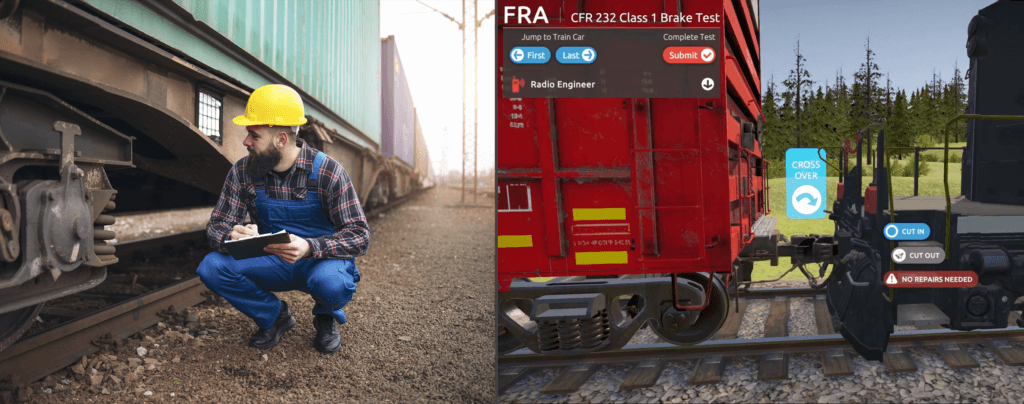This article was originally published in the Railway Age on November 17, 2021
The costs railroads can save with simulation training recertifications are significant. Railroads have to meet recertification standards for FRA compliance, performing check-in training for safety reasons. However, if railroad workers aren’t able to accurately and immediately identify danger points, disaster is imminent.
This is why railroads take recertification so seriously, and it’s also why they’re increasingly adopting simulation trainings, like the FRA-approved Air Brake Test (CFR 232, 238); the Pre-Departure Inspection (CFR 215, 238); and, the Locomotive Daily Inspection (CFR 229) to meet the recertification requirements and to enhance long-term retention of learnings.
But, exactly how much does simulation training cost —and how does that compare to traditional training costs? That’s something we’re going to break down in this piece, along with some additional ROI considerations that are already on your radar and may benefit from a realignment.
Training Cadence Considerations
There are many costs to consider when planning railroad recertification training—and when planning any other training for that matter. These trainings vary by timing, topic and by craft.
There can be five-day, three-day and even half-day options, considering. And the training varies in intensity, as the checklist for a conductor on a freight train (for example) is extensive when compared to that of a carman. It’s an apples-to-oranges comparison though, as there are different things each needs to focus on. So, naturally each training is different.
To jump right in, we see every individual in each craft given operational tests two or more times per year, and then recertified in everything approximately every two to (at the most) three years to meet FRA requirements.
Whether we’re discussing an off-the-cuff check-in, an annual training or one required once every three years, there are some standard costs that apply to each and can put training spend in perspective.
Typical Training Costs
For our example, let’s assume we have approximately 12 students from each craft in an average class size. Each will be missing work for a three-day training. They’ll also miss the day before and day after the training, due to shift scheduling. We also need to factor in people to replace them on the job, so each cost is doubled. With that in mind, we can extrapolate some real costs.
Calculating the daily rate of each and multiplying by the number of days away for training, multiplied by the number of workers, we’d have:
Equipment Costs:
Taking a locomotive out of service for the day comes at a tremendous cost, as it will be out of commission for at least a full day. Cost would be specific to the railroad and location, but at an opportunity cost of many thousands of dollars per minute, as valuable cargo that could be moving is not, having that locomotive operating would be preferable.
And then if the locomotive is damaged during training, repairs need to be factored in as well.
For freight trains, there are typically cars available to work on, but this all needs to be coordinated and adds to a hump yard’s already chaotic schedule.
Instructor Costs: $300,000
Instructors’ time needs to be factored in as well. Not their salaries, as that’s a set cost that will always be needed, but the way they’re using their time. There are approximately 50-60 supervisors fully engaged in leading these trainings throughout the year on a full-time basis at a Class I railroad, as training spans every variety of craft. So, rethinking how to best use this expertise is wise.
But their time is also spent on updating materials throughout the year as well, particularly at the start of each new year when the new rules and regulations come out. And this process is fairly expensive as well.
Starting on January 1 and for the first two-three weeks of that month, instructors and subject matter experts are tasked with updating classroom programs. Each salaried person will be paid approximately $6k for the month (for 50 people), with most of that month focused solely on this effort. And these updates happen across the board.
And finally, these trainings happen multiple times per year to cycle everyone through.
As we can see above, numbers exceed $500k using a fairly conservative cost estimate for training and instructors alone. Training is an expensive undertaking, that’s for sure. And one that’s entirely necessary and worthwhile. But now, imagine creating a training where most of those costs could suddenly disappear? Because, with simulation training, most of them can.
Simulation Training Savings
Simulation training eliminates most of those costs. Let’s take each in turn:
- Missing time from work is cut drastically. The amount of time it takes to train workers via instructor-monitored simulation vs an instructor-led classroom event offers significant time savings. For example, 8hrs of classroom instruction can typically be replaced by one hour of simulation training. And it can be done before or after a shift, instead of in place of it.
- This also eliminates the need for hosting training in a specific facility. Instructors can complete training individually, as needed, with one set cost.
- Equipment is no longer out of commission, nor at risk. And also —workers are able to explore its inner workings and prepare for emergency situations in ways they could never practice for before.
- Time spent hosting in-person trainings and on updating CBTs and manuals at the start of the new year, is redirected to consistent updates to simulation training modules during the year. This creates a mindset of continuous improvement and encourages innovation, along with enhanced safety.
- COVID safety protocols need to be created for even small group gatherings and this cost can be significant too.
And there are additional unrealized cost savings as well.
Beyond Cost: Cutting Emergency Response Time
There’s much to be said for experiencing a thing ‘in the moment’—that is, recreating it in the actual environment one will be required to perform said task when an emergency strikes.
But most emergencies defy replication, so the next best thing is practice. And we know that repeated practice under any circumstance trumps occasional practice that’s done in a rush with numb fingers (when using inclement weather as an example). This is where simulation training offers a unique advantage.
“Simulation offers a safe and efficient space for the re-certification of skill sets and concepts in compliance with operating practices. We are afforded the opportunity to create both routine and rare scenarios that ensure team members are prepared for real world application. Leveraging the mobility of this solution allows a nimble, proactive approach to addressing certification requirements.”
Billy Crafford, Manager of Client Technology Services at Norfolk Southern.
Knowing how to replace a knuckle is taught on day one, and is something you can realistically go 30 years without having to do it. And if you do need to, having a virtual interactive manual to refer to and help you change it can be a lifesaver, literally.
Simulation training is not meant to replace hands-on training. Instead, simulations complement classroom training by filling in the gaps where OTJ training can fall short. Learners are much more engaged when doing something than when they are in a lecture environment, for example. And the repetition of an action beyond those real-world hands-on experiences is what will separate those who perform the action as a second-nature reaction vs those that will hopefully remember their classroom training where they were distracted and only half-listened. And overtired workers, taking on additional overtime hours to fill in for those traveling for training, are likely a bit slower to act than one would like.
In scenarios where a few seconds count, taking immediate action to grease the rail and get a car out of the way or whatever needs to happen, must be done correctly —and quickly. And having one less, potentially deadly, variable on the table during these times is priceless.
This article was originally published in the Railway Age on November 17, 2021




